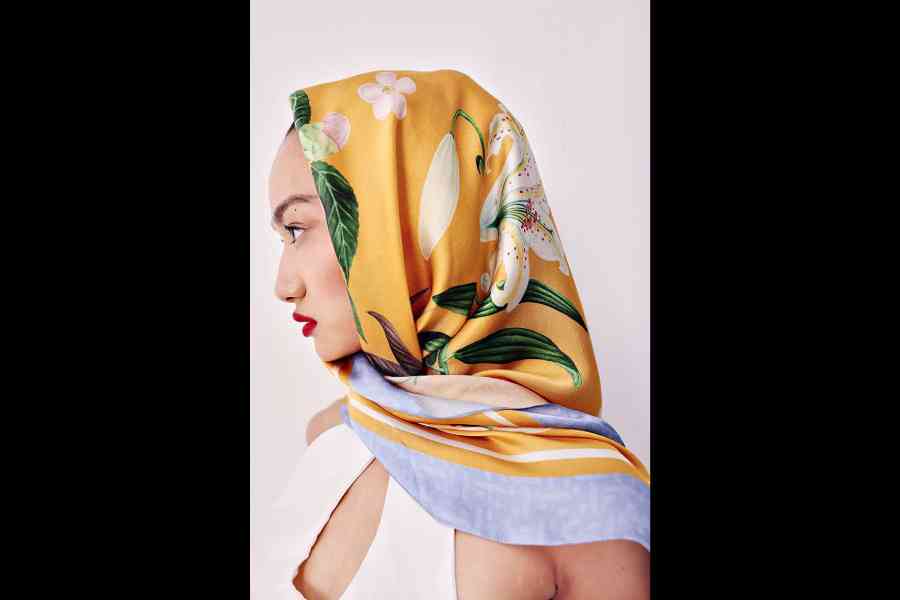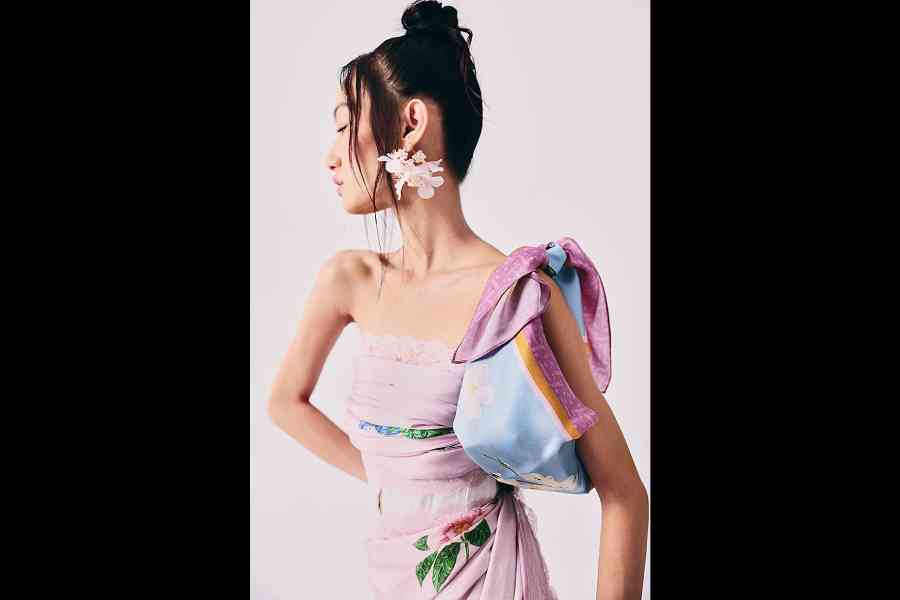Delhi-based fashion designer Ashdeen Z. Lilaowala’s ‘Postcard from Japan’ is a beautiful story of florals and prints, full of romance and fusion fun. Ashdeen chatted with t2 on the collection and why it’s important to keep reinventing the sari.
‘Postcard from Japan’ looks beautiful...
Every year, we have always looked at print as an important part of our collection and we have started from scratch to design the prints and create a whole mood. This year we were inspired by these stamps. The government in Japan releases seasonal stamps. There are flowers for summer, winter, autumn and spring. We took those 12 flowers that represent the whole calendar and used them in print and created artworks. First, they are all hand-painted and then digitally scanned and then we take the scanned images and create artworks on the computer and then digitally print them and do the sari. All the stamps have these borders or edges that are perforated to tear the stamp. To make it more Parsi and give it our touch, we used lace to create that impression of perforation and add another layer to the sari.

We worked with a young stylist to make it contemporary and fun and to show people that you can style the sari in many ways. We have used different elements like we paired it with a corset and a skirt. Like how a stylish Japanese lady would play with a kimono, we played with a sari.
We have also done stoles and scarves. For the square scarves, we looked at how in Japan they wear them stylishly, formally or informally. We have also wrapped a lot of things in scarves... the idea of taking fabric pieces to carry stuff. In some of the photos we have done very cool bags, but they are actually just scarves, wrapped and knotted, created to give a look of a clutch bag.
The palette is soothing and fresh...
We wanted the colours to be vibrant and fresh for summer and an easy-on-the-eye palette. Most of the country has summer throughout the year. And, these colours look very nice on Indian skin tones and work for a large variable. A lot of young girls today want to wear saris but in a different way. This was a way to show them they could spice it up and change it around.
You have been constantly pushing boundaries with the sari...
Girls are wearing saris on occasion or for important meetings and dinner. The consumer is aware now and there are a lot of options in terms of saris. It’s not just a border and plain sari. There is a lot more that has evolved and in terms of technique, there is such an abundant range, from an ajrakh sari to a Bengali sari to a bandhni or leheriya. That’s where we have to make sure that every season we are doing something different and new that would be appreciated and people would still be interested to pick up. That has to build with them wearing it and getting compliments. Then you would be like, let me try wearing one more. Some people are more comfortable wearing Indian silks and some tussores. Today, with so much information and so many of these girls posting about their saris and what they felt in it and what emotion they have with it... there is a bond. A sari still has a certain sense of pride when people wear it.
(In earlier days) we didn’t have stitched apparel, in India. You didn’t get kurta sets easily or pants and shirts and had to go to a tailor to get them stitched. Sizing was an issue. With retail and fast fashion coming in, it is abundantly available. That has changed our narrative about why we are moving towards things that are easier to maintain and wear. Not that the sari is difficult to wear but it’s about a matter of being comfortable.... If you have grown up in a house where you have seen your mother or grandmother drape it, you’ll intuitively know... it’s not rocket science, let’s face it. People wear much more elaborate clothes, costumes and headgears... Sardar men wear turbans every day and so neatly... somewhere it is intrinsic in our system to wear drapes or tie something around us, the idea of unstitched cloth.

I guess over the years we have gotten comfortable putting a kurta on or a T-shirt. A few years ago, athleisure was just considered for the gym. Today, people wear it formally for dinner. The lines of what you can wear, where you can wear and how you can wear are blurring pretty fast. That is lovely for the sari also, which the younger lot is wearing with jeans and bralettes. It’s a great mix and match.
Does it all boils down to how you view life, finally?
Absolutely. It’s about choices and circumstances. Recently, I was in London and I saw this woman in a sari and a bindi and bangles and she looked fabulous. Pallu flying....
We are very positive about the sari... it’s not something that will die or go away... today women are wearing it with a lot more pride, they know what they are wearing and appreciate their textiles and it may have left the everyday zone, but there is a certain sense of elevation.

